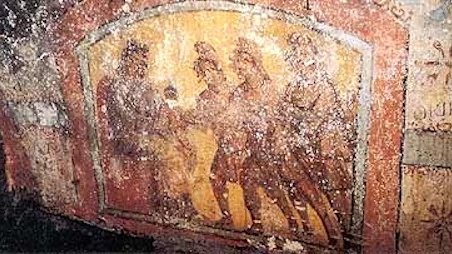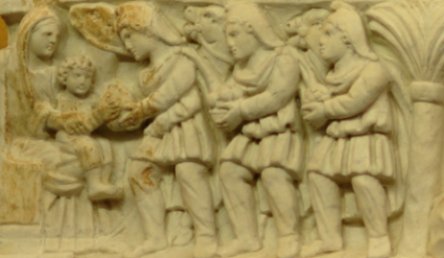
Catacomb of Marcellinus, Rome.

Lid of the sarcophagus of Crispina.
The matching attributes of Christ and
Dionysus/Bacchus have occasioned much debate. Understandably, the
connection is not popular in the Christian world, and the character of
the two does not match: after all, Dionysus was a lascivious, drunken
rioter. The matching attributes are incidental, some would say
coincidental. According to legend, Dionysus was born around about the
feast of Saturnalia (late December), the son of a god and a virgin.
Among his talents was the ability to turn water into wine. He travelled
to the underworld for three days, then returned. He died on a tree, then
rose from the dead.
The Dionysus mosaic was on the floor of a grand dining
room, and the sophisticated guests would be well aware of these
parallels. Just as today, the Christian reference in the pagan image
would not have been lost on them. Neo Paphos was the most important
pagan site on Cyprus, with a temple to Aphrodite. Since Constantine
Christianity was the belief system of the empire, but paganism had not
gone away. Indeed, it has been suggested that Christian monotheism had
influenced residual paganism, with devotion to a single deity, such as
Dionysus, rather that to the entire pantheon of gods.
So,
what was the purpose of the mosaic? Some have suggested that it was
intended as a humorous parody of the story of the Magi, for the
amusement of the pagan guests.
Very telling is this extract from the Acts of the Apostles, when
Paul and Barnabas arrived in Paphos.
And when they had gone through the isle unto Paphos, they
found a certain sorcerer, a false prophet, a Jew, whose name was
Barjesus: Which was with the deputy of the country, Sergius Paulus, a
prudent man; who called for Barnabas and Saul, and desired to hear the
word of God. But Elymas the sorcerer (for so is his name by
interpretation) withstood them, seeking to turn away the deputy from the
faith. Then Saul, (who also is called Paul,) filled with the Holy Ghost,
set his eyes on him, And said, O full of all subtilty and all mischief,
thou child of the devil, thou enemy of all righteousness, wilt thou not
cease to pervert the right ways of the Lord? And now, behold, the hand
of the Lord is upon thee, and thou shalt be blind, not seeing the sun
for a season. And immediately there fell on him a mist and a darkness;
and he went about seeking some to lead him by the hand. Then the deputy,
when he saw what was done, believed, being astonished at the doctrine of
the Lord. Ch 13 v 6-12.
As far back as c40 AD debate raged across
the island. The prudent deputy, Sergius Paulus, was clearly prepared to
listen to both sides. The centuries passed, but the debate continued. Could this, therefore, be the function of the
mosaic – to initiate debate, as the guests lay on their couches eating their
sumptuous meal?
Home page: explore the site